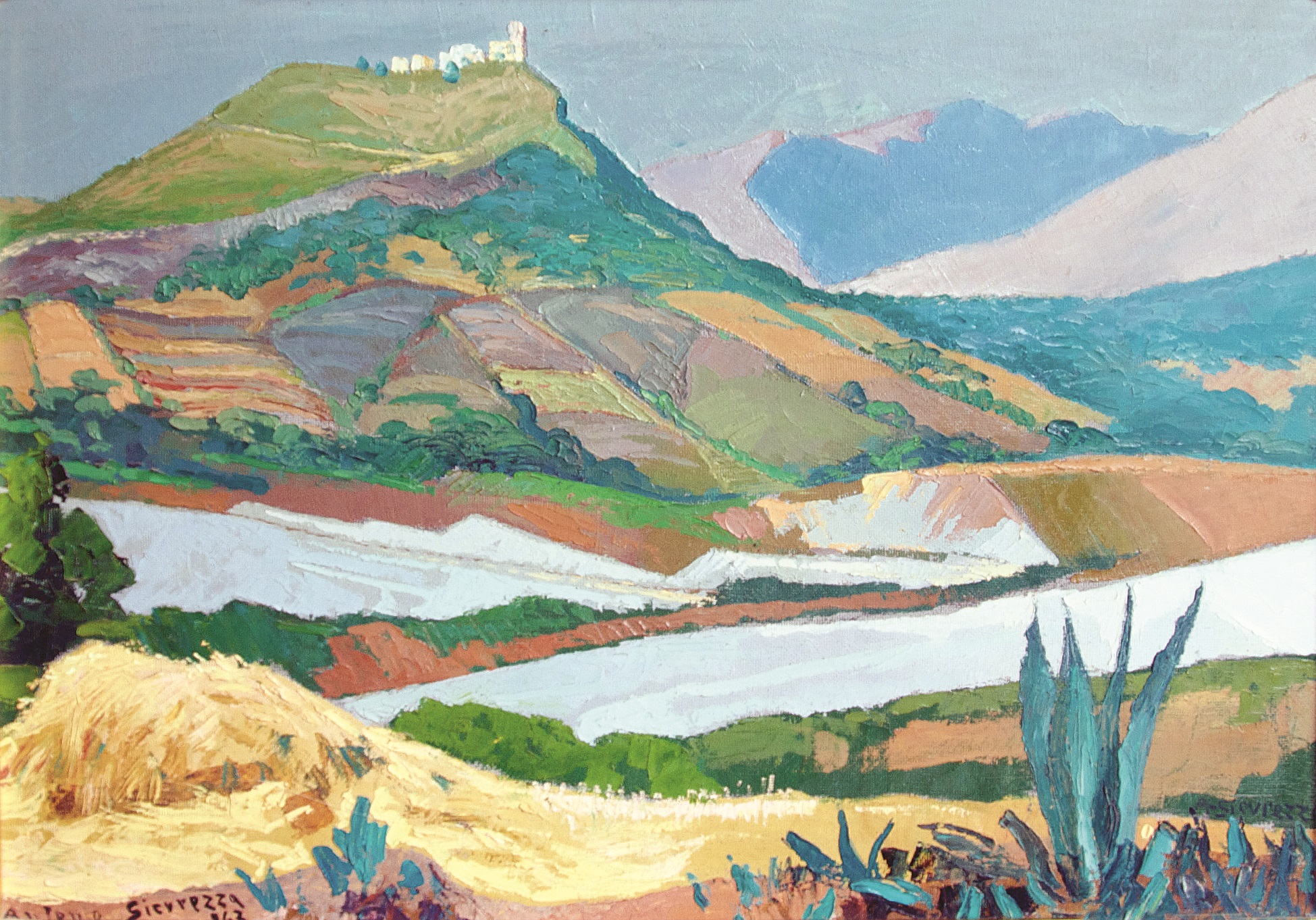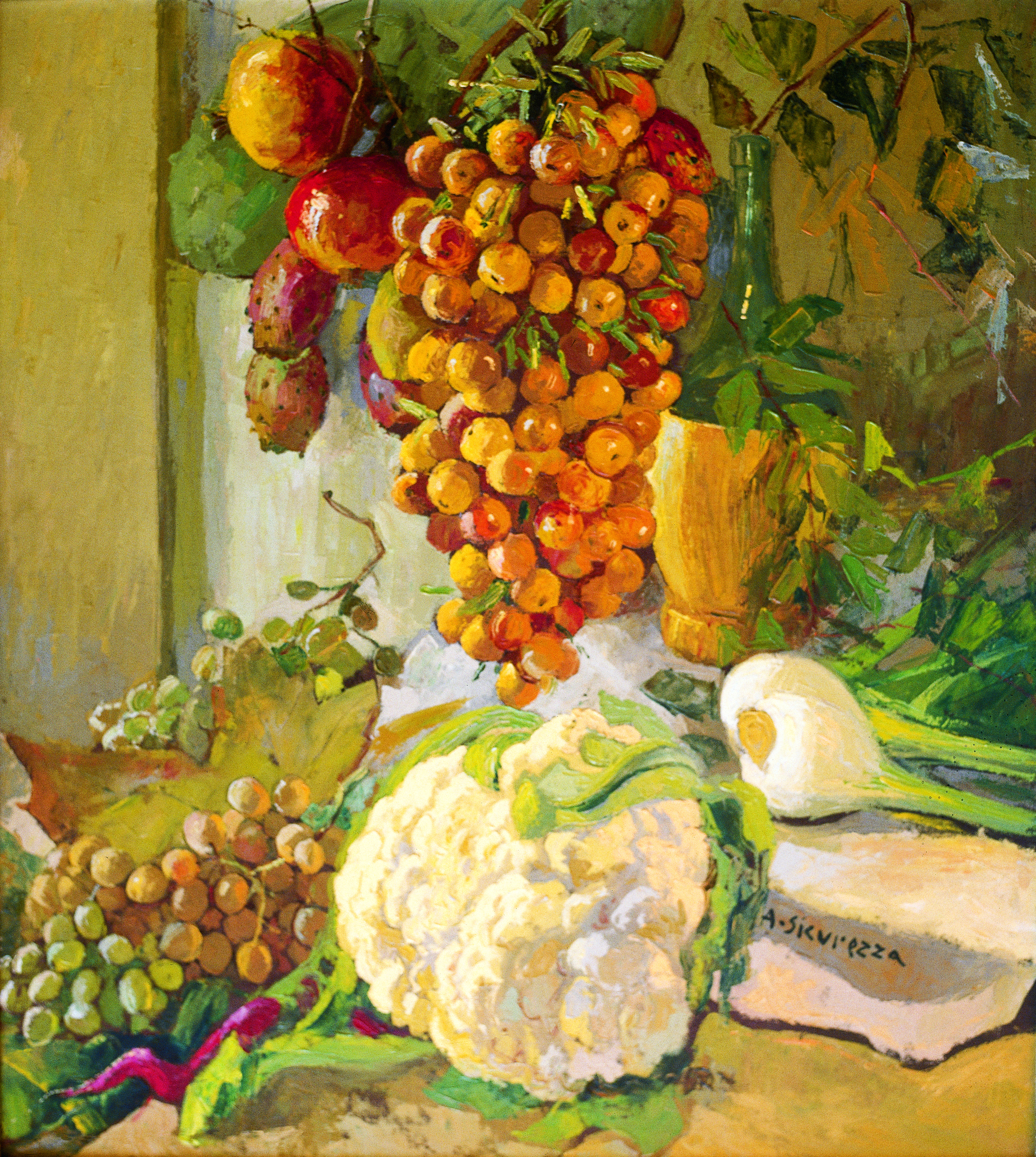INTRODUCTION
Country in Summer
Antonio Sicurezza, Public domain, via Wikimedia Commons
Antonio Sicurezza (1905–1979) was an Italian painter whose work bridges tradition and modernity, devotion and intimacy, precision and warmth.
For much of the 20th century, he created paintings that spoke both to ordinary people and to the sacred spaces of churches and civic halls.
His art is distinguished by a natural ease in the choice of subjects, a luminous use of color, and an extraordinary balance between realism and emotional depth.
Today, his paintings are cherished in both public and private collections, celebrated for their themes of dignity, spirituality, and everyday life. This essay explores his life, his technique, his subjects, and the enduring value of his paintings—while taking a closer look at five of his most memorable works.
The Ease of Choosing Subjects
One of the hallmarks of Sicurezza’s art was his instinctive relationship with subject matter. Unlike artists who agonize over themes, Sicurezza seemed to select his subjects with disarming simplicity. He could turn from painting a sacred scene for a church altarpiece to rendering a humble head of cauliflower in a still life without losing depth or authenticity.
His range was broad:
-
Religious themes that connected faith with local landscapes.
-
Portraits that gave dignity to everyday people.
-
Landscapes that captured the serene atmosphere of towns, alleys, and coastal views.
-
Still lifes where ordinary objects—onions, sunflowers, a cauliflower—became radiant symbols of life’s quiet beauty.
-
Female nudes treated with dignity, not sensationalism, but with a profound respect for form and humanity.
This ease of selection reflects not carelessness, but a deep confidence in his craft. For Sicurezza, art was not about hunting for a subject but about revealing the extraordinary within the ordinary.
The Themes of His Art
Sicurezza’s body of work can be seen as variations on a few enduring themes:
-
Human dignity—Whether in portraits, nudes, or depictions of saints, Sicurezza sought to ennoble the human figure. His works reveal an almost spiritual respect for the people he painted.
-
Spiritual presence in the familiar – His religious paintings often situate saints and biblical figures in recognizable settings, such as the Gulf of Gaeta or the streets of Formia. This choice gave sacred art a sense of immediacy and belonging.
-
The sacredness of labor and humility – In landscapes and civic commissions, there is often a tribute to ordinary life, to farmers, workers, and townspeople. He believed beauty was not confined to grand subjects but present in everyday existence.
-
Nature as serenity – His landscapes are never purely descriptive; they embody tranquility, light, and a meditative stillness.
-
The poetry of objects—Sicurezza’s still lifes transform vegetables, flowers, or everyday household items into compositions that radiate warmth and tenderness.
The Use of Color
Color in Sicurezza’s work is more than visual decoration—it is emotional language. Early in his career, he worked within a more traditional palette, but as his style matured, his colors grew bolder, more vibrant, and more passionate.
He often employed oil paint with a spatula rather than a brush. This technique gave his canvases a physical richness, with layers of color that almost seem sculpted. His hues are warm and Mediterranean: earthy ochres, sunlit yellows, deep sea blues, and radiant greens.
Yet Sicurezza balanced intensity with subtlety. Around the edges of his compositions, he frequently left spaces deliberately unfinished, creating contrast between precise detail and impressionistic suggestion. This approach not only directed the viewer’s focus but also introduced a quiet sense of mystery.
Where His Paintings Are Displayed
Antonio Sicurezza’s paintings can be found across Italy, particularly in the Lazio region, where he lived and worked. His works remain present in:
-
Churches—Numerous parishes display his religious commissions, including altarpieces such as Saint Albina and Annunciation. These works still serve their original function, engaging communities in devotion.
-
Civic halls and municipal collections – Cities such as Formia and Minturno preserve his works in town halls, celebrating him as a painter who gave voice to local identity.
-
Private collections—Collectors continue to prize his still lifes, portraits, and landscapes, ensuring his legacy extends beyond public institutions into intimate domestic spaces.
This dual presence—sacred and secular, public and private—mirrors the duality of his art: at once deeply rooted in community and universally appealing.
Valuation of His Art
On the art market, Sicurezza’s works have been accessible compared to those of more widely known contemporaries, with sales recorded in both Italian and international auctions. Prices typically range from a modest few hundred to over a thousand dollars, depending on the subject, size, and provenance of the work.
-
Still lifes and nudes are frequently sought after for their intimacy and technical skill.
-
Landscapes and civic works have historical resonance, linking directly to places and traditions.
-
Religious paintings, while less common on the market due to their church settings, are especially valued when available.
This affordability has made Sicurezza’s paintings attractive to collectors who appreciate authentic 20th-century Italian realism without the prohibitive costs of more famous names.
Five Paintings by Antonio Sicurezza

Saint Albina
Antonio Sicurezza, Public domain,
via Wikimedia Commons
1. Saint Albina (1964)

Antonio Sicurezza, Public domain,
via Wikimedia Commons
Commissioned specifically for the revered Church of Saint Erasmus in Formia, Sicurezza's Saint Albina stands as one of his most compelling and defining religious works.
The titular saint is depicted with profound solemnity, her figure rendered with a striking clarity and an undeniable grace that immediately draws the viewer's eye.
What truly elevates this painting to a remarkable status is Sicurezza's innovative approach to its setting. Instead of relying on a distant, idealized, or anachronistic background, he boldly integrates the familiar and distinctly local Gulf of Gaeta.
In doing so, he achieves a powerful connection, making holiness feel profoundly present and intimately local, effectively bridging the spiritual realm of heaven with the tangible earth of his beloved region.
2. Annunciation (1967)
Displayed in the Church of Carmine in Formia, this altarpiece depicts the biblical moment when the Angel Gabriel announces to Mary her divine role. Rather than overwhelming grandeur, Sicurezza chose clarity and accessibility. Mary is shown not as an untouchable icon, but as a young woman rooted in everyday reality. The architectural details echo local surroundings, ensuring parishioners felt the sacred event unfolding in their midst.
3. Still Life with Cauliflower (1971)

Still Life with Cauliflower
Antonio Sicurezza, Public domain, via Wikimedia Commons
This oil on panel is a testament to Sicurezza’s remarkable ability to elevate the mundane to the realm of the magnificent. What appears at first glance to be a simple still life, centered on a cauliflower, quickly reveals itself as a poetic exploration of form and light. Placed thoughtfully among other less defined vegetables, the cauliflower commands attention.
Sicurezza renders its every detail with extraordinary precision: the intricate, clustered florets, the subtle variations in its crisp texture, and the captivating interplay of light and shadow across its surface.
Through his masterful brushwork, the humble cauliflower transcends its ordinary origins, appearing almost monumental. Its pristine whiteness glows with an inner luminosity, creating a striking contrast against the deeper, more earthy tones of its surroundings.
This painting is a vivid embodiment of Sicurezza’s core artistic philosophy: that profound beauty and compelling narratives can be found not in grand subjects, but in the most humble and overlooked aspects of everyday life. It’s a powerful reminder to see the extraordinary within the ordinary.

Alley of Itri.
Antonio Sicurezza, Public domain,
via Wikimedia Commons
4. Alley of Itri (1970)

Antonio Sicurezza, Public domain,
via Wikimedia Commons
This evocative landscape by Sicurezza is more than just a painting; it's an invitation to step into the tranquil heart of Itri, a picturesque town nestled in Italy's Lazio region. The scene focuses not on a sweeping panorama, but on a quiet street, a narrow alleyway that immediately radiates a sense of intimacy and calm.
The genius of the composition lies in its use of natural light, which floods the alley, meticulously emphasizing the rugged stone textures of the ancient buildings and illuminating the subtle architectural details that might otherwise go unnoticed. It is precisely this focus on a "corner of life," rather than a grand vista, that gives the painting its profound charm and authenticity.
Sicurezza has lovingly preserved a moment, a feeling, capturing the timeless character of Italian towns. His ability to balance a gentle nostalgia for a bygone era with a vibrant sense of present vitality is evident in every brushstroke, making this a truly transportive piece.

Lagoon in Grado
Antonio Sicurezza, Public domain, via Wikimedia Commons
5. Lagoon in Grado (1973)

Antonio Sicurezza, Public domain, via Wikimedia Commons
In this work, Sicurezza shifts his gaze northward, capturing the serene waters of Grado. The painting glows with tranquility—muted reflections on water, soft horizons, and the delicate play of light.
It is a meditation on stillness, where atmosphere becomes more important than detail. This painting exemplifies his mastery of mood, using color to evoke emotion beyond representation.
Sicurezza’s Legacy
Antonio Sicurezza’s art embodies what might be called “subjective realism.” His works are realistic but not bound to mechanical precision. Instead, they are infused with personality, warmth, and poetic interpretation.
His choice of subjects reveals his philosophy: nothing is too humble to be worthy of art. His use of color demonstrates his Mediterranean heritage—sunlit, vibrant, but never artificial. His technique of combining meticulous details with unfinished suggestions makes his canvases alive with tension and depth.
Above all, his legacy is twofold:
-
In communities, where his paintings still adorn churches, connecting generations of faithful to art that speaks in familiar language.
-
In collections, where his still lifes and portraits continue to remind viewers of the dignity and beauty embedded in daily life.
Conclusion
Antonio Sicurezza may not occupy the same global fame as some of his contemporaries, yet his art holds enduring significance. He offers an alternative vision of modern Italian painting—one rooted in locality, spirituality, and respect for the ordinary. His works invite us to see holiness in familiar landscapes, beauty in vegetables and alleys, dignity in every figure he painted.
In his paintings, there is no hierarchy between sacred and secular, grand and humble. Everything is painted with equal devotion. That, perhaps, is Sicurezza’s greatest contribution: showing that art, like life, is richest when it embraces all its subjects with sincerity.